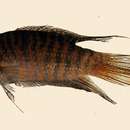Diagnostic Description
provided by Fishbase
Caudal fin forked, both lobes elongate in males (Ref. 559), with filamentous extension in each lobe (Ref. 43281); lower margin of preorbital sharply serrated (Ref. 559); conspicuous dark brown opercular spot with whitish posterior margin (margin red in life); body with 7-11 bold, dark bars on pale yellowish background in preserved specimens (blue bars on reddish background in life); dark stripe crossing eye connecting opercular spot with eye; top of head and predorsal body with dark spots; posterior tip or margin of scales on body not darker than scales (Ref. 42924).
Diseases and Parasites
provided by Fishbase
Fin Rot (early stage). Bacterial diseases
Diseases and Parasites
provided by Fishbase
Ichthyobodo Infection. Parasitic infestations (protozoa, worms, etc.)
Diseases and Parasites
provided by Fishbase
Fin-rot Disease (late stage). Bacterial diseases
Diseases and Parasites
provided by Fishbase
Bacterial Infections (general). Bacterial diseases
Life Cycle
provided by Fishbase
The species is a bubble-nest builder; the male swims to the surface, draws a little air into his mouth and envelops it in a film of saliva thereby forming bubbles; upon building the nest, the male drives the female towards it; female spawns then male follows; male picks up the fertilized eggs in his mouth and pushes one by one into each bubble of the nest; male guards eggs until hatching (Ref. 5258). Produces up to 500 eggs (Ref. 1672).
Morphology
provided by Fishbase
Dorsal spines (total): 11 - 17; Dorsal soft rays (total): 5 - 10; Anal spines: 7 - 22; Analsoft rays: 9 - 15; Vertebrae: 27 - 29
Trophic Strategy
provided by Fishbase
Can colonize stagnant water bodies with very low oxygen content (air breather). Occurs in streams, paddy fields and ditches (Ref. 5258). Feeds on small aquatic animals including small fish.
- Recorder
- Drina Sta. Iglesia
Biology
provided by Fishbase
Adults inhabit any kind of lowland habitats from heterogeneous structured margins or backwaters of large rivers to small streams and irrigation channels on farmland (Ref. 42924). Can colonize stagnant water bodies with very low oxygen content (air breather). Found in streams, paddy fields and ditches (Ref. 5258). Feed on small aquatic animals including small fish. First ornamental fish to be brought to Europe (France 1869, Germany 1876) after the goldfish (Ref. 13371). Males will fight each other (Ref. 1672). Aquarium keeping: minimum aquarium size 80 cm (Ref. 51539).
Importance
provided by Fishbase
fisheries: of no interest; aquarium: commercial

